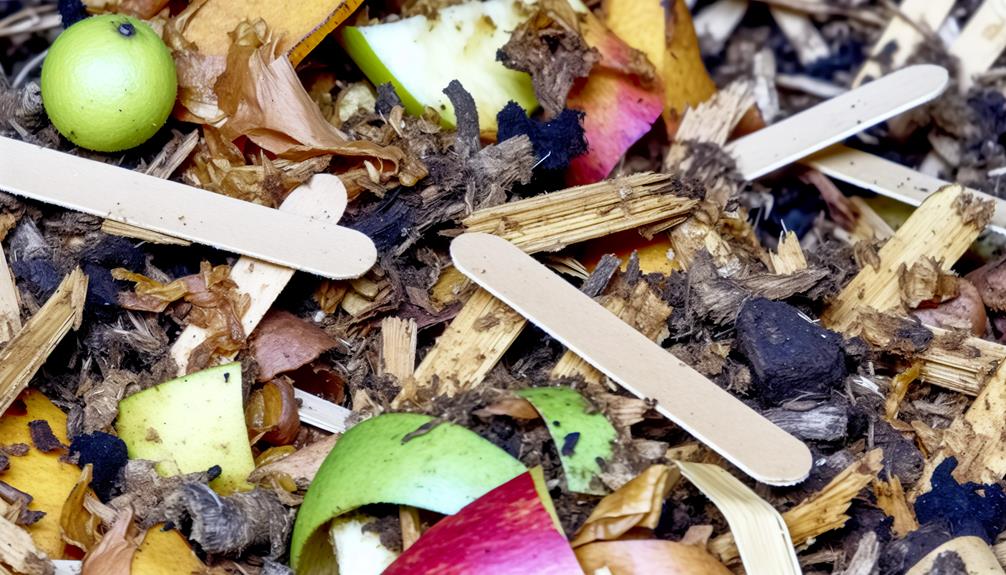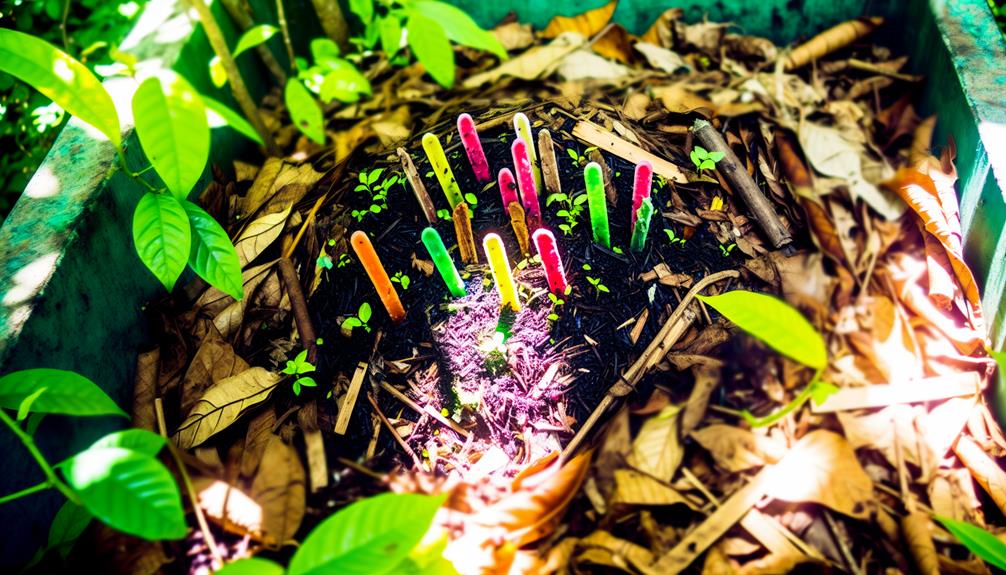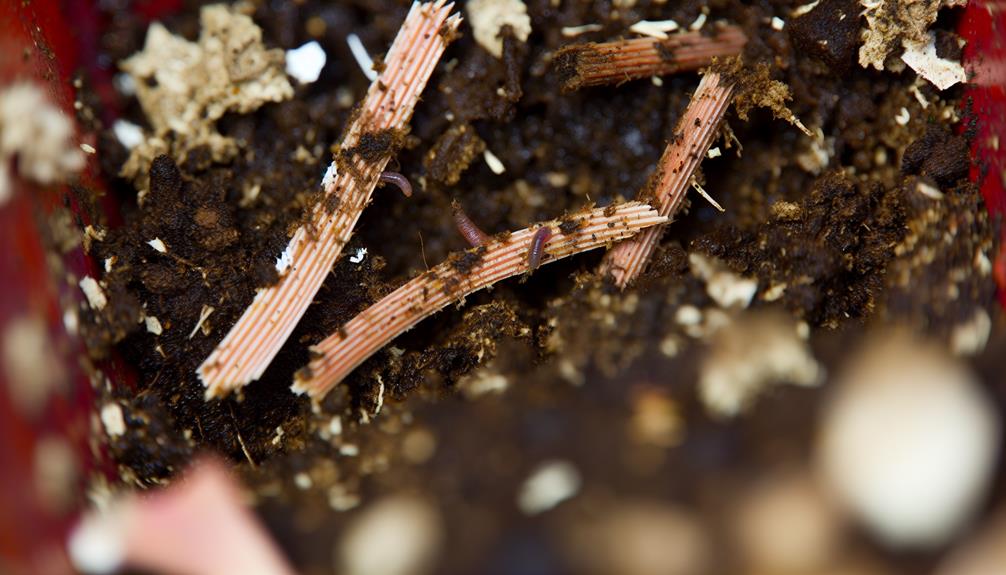

Yes, you can compost popsicle sticks if they’re made from untreated birch wood and free of paint or plastic coatings. Popsicle sticks are biodegradable, but breaking them into smaller pieces helps them decompose faster. Make sure to mix them with other organic materials and maintain a balanced carbon-to-nitrogen ratio.
Keep your compost moist but not waterlogged, and turn it regularly to promote decomposition. Avoid sticks with artificial flavors, dyes, or coatings, as these can introduce harmful chemicals into your compost. Understanding these guidelines will guarantee you create high-quality compost for your garden. Interested in more such tips?
Popsicle sticks are typically made of birch wood. The manufacturing process begins with sourcing high-quality birch trees, known for their strength and smooth texture. You’ll find that birch is chosen because it’s sturdy yet flexible, making it perfect for handling those frozen treats.
Material sourcing is important; it guarantees that only the best wood is selected, which contributes to the overall durability and safety of the sticks.
After the birch wood is harvested, it’s sent to a processing facility. Here, the wood is cut into thin strips and then dried to remove any moisture. This step is vital because it prevents the sticks from warping or cracking. Next, the strips are sanded down to achieve a smooth finish, ensuring there are no splinters that could harm you.
The final step in the manufacturing process involves cutting the strips into the familiar rounded shape.
Understanding the material sourcing and manufacturing process helps you appreciate the craftsmanship that goes into each popsicle stick. It’s fascinating to see how something so simple can be made with such attention to detail, ensuring it’s safe and reliable for everyone.
Ever wondered if those wooden sticks from your favorite frozen treats will break down naturally over time? The good news is, popsicle sticks are typically made of wood, a biodegradable material. Because they’re organic, they can decompose, offering an environmentally friendly option for disposal.
However, the decomposition rate can vary based on several factors. Wooden popsicle sticks usually take several months to a few years to break down fully, depending on environmental conditions like moisture, temperature, and microbial activity.
In a compost pile, where conditions are optimized for decomposition, these sticks will break down faster compared to simply being left in a landfill. The presence of heat and microorganisms aids in accelerating the process.
To make certain you’re minimizing the environmental impact, make sure to break or cut the sticks into smaller pieces before adding them to your compost pile. This increases the surface area, allowing microorganisms to work more efficiently.
Additionally, avoid sticks that have been painted or coated, as these can introduce harmful chemicals into your compost.
Also Read: Can You Compost Cadaver?
Composting popsicle sticks not only reduces landfill waste but also enriches your soil with valuable nutrients. By incorporating these wooden sticks into your compost pile, you’re contributing to waste reduction and promoting a healthier garden environment. This simple act can make a significant impact on your garden’s soil enrichment.

When popsicle sticks break down, they release essential nutrients like carbon into the compost. This process helps create a balanced compost mix, which in turn, improves soil structure and fertility. Your plants will thrive in this nutrient-rich environment, leading to healthier growth and better yields. Plus, by diverting popsicle sticks from landfills, you’re helping to reduce the overall waste burden.
Including popsicle sticks in your compost also encourages a sense of community and shared responsibility for the environment. It’s a small but meaningful way to connect with others who are equally committed to sustainable practices. You’ll find that participating in composting fosters a sense of belonging among like-minded individuals who value eco-friendly living.
To begin composting popsicle sticks, you’ll need to confirm they’re made of untreated wood and free of any plastic or paint. This guarantees the sticks will break down naturally without introducing harmful chemicals into your compost.
Next, focus on popsicle stick preparation. Break the sticks into smaller pieces to accelerate the decomposition process. You can use a pair of garden shears or simply snap them by hand. Smaller pieces decompose faster, making this step essential for effective composting.
Now, let’s talk about compost bin placement. Choose a spot in your yard that receives a good mix of sun and shade. This balance helps maintain an ideal temperature for composting.
Place your popsicle sticks in the center of the compost heap, mixing them with other organic materials like kitchen scraps and yard waste. This mixture provides necessary nutrients and helps maintain moisture levels.
Remember to turn the compost regularly. This aerates the pile, promoting faster decomposition.
In a few months, those popsicle sticks will break down and contribute to rich, fertile compost that benefits your garden. By following these steps, you’ll be part of a community dedicated to sustainable living and waste reduction.
Also Read: Can You Compost Rust?
While composting popsicle sticks is straightforward, you might encounter some issues that could slow down the process or affect the quality of your compost. One common problem is the risk of contamination. Popsicle sticks often come into contact with artificial flavors, dyes, or coatings that aren’t compostable. Before tossing them into your compost bin, make sure they’re free from such contaminants. If you’re unsure, it’s better to err on the side of caution and discard them in the trash or repurpose them for crafts.

Another issue is the decomposition time. Popsicle sticks are made of wood, which takes longer to break down compared to vegetable scraps or leaves. To speed up the process, you can break the sticks into smaller pieces. This increases their surface area, allowing microbes to work more efficiently. Mixing them with nitrogen-rich materials like grass clippings can also help balance the carbon-to-nitrogen ratio, promoting faster decomposition.
Lastly, keeping your compost moist but not waterlogged and turning it regularly will aid in breaking down the sticks. By addressing these potential issues, you can enjoy high-quality compost that enriches your garden and fosters a sense of community and shared responsibility.
You can’t compost painted popsicle sticks because chemical paints can leave toxic residues. It’s safer for the environment and your compost pile to avoid adding anything that might harm the beneficial organisms you’re nurturing.
You’re wondering if colored popsicle sticks are safe for composting. Checking for dye toxicity is crucial. Opt for eco-friendly alternatives or natural sticks to guarantee your compost remains safe and sustainable for everyone.
The decomposition process of popsicle sticks can take several months to a few years, depending on conditions. By composting them, you’re helping reduce environmental impact and fostering a community that values sustainability and responsible waste management.
Yes, composting popsicle sticks can attract pests. To guarantee pest prevention, maintain proper compost aeration and balance green and brown materials. You’ll create a healthier compost environment, fostering a sense of community with fellow eco-friendly enthusiasts.
You might wonder if popsicle sticks affect the pH level of compost. They don’t notably alter it. The wood breakdown helps maintain nutrient balance, enriching your compost and fostering a sense of community through sustainable practices.
To sum up, you can compost popsicle sticks if they’re made of natural wood. Make sure you break them into smaller pieces to speed up decomposition.
Regularly turn your compost pile to maintain aeration. Watch out for sticks with paint or coatings, as these shouldn’t be composted.
By following these steps, you’ll efficiently recycle popsicle sticks, contributing to a healthier compost and a more sustainable environment. Happy composting!
